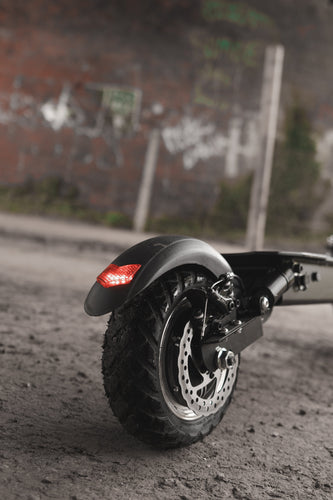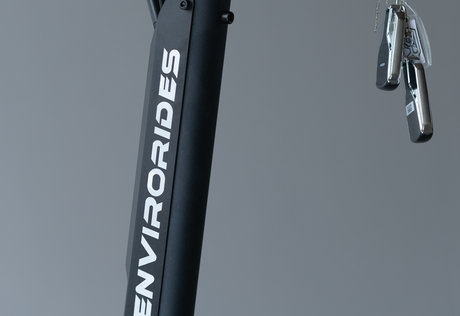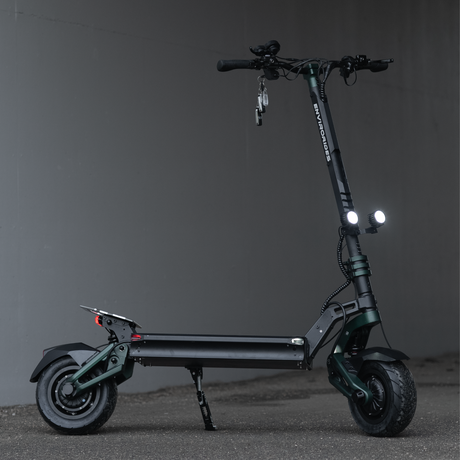The lifespan of an electric scooter is a multifaceted question, influenced by numerous factors. Unfortunately, nothing can last forever, but the longevity of your electric scooter can be significantly extended with proper care and attention. If you invest time and effort into maintaining your electric scooter, it's likely to surpass the average lifespan, providing you with reliable transportation for an extended period.
While it's a common belief that the lifespan of electric scooters hinges solely on usage frequency and the type of roads they navigate, there's more to the equation. Beyond these aspects, a spectrum of factors comes into play, influencing the overall durability of your electric scooter.
From the intricacies of battery life and carriage capacity to the impact of pressure and weather conditions, this article aims to unravel the comprehensive list of elements that determine how long electric scooters endure. Additionally, valuable tips will be shared to guide you on extending the lifespan of your electric scooter, ensuring optimal performance and longevity.
How Long Do Electric Scooters Last on Average?
The lifespan of an electric scooter can vary based on several factors. On average, well-maintained electric scooters can last anywhere from three to five years. However, this estimate is contingent on various elements such as usage patterns, maintenance practices, and the quality of components.
For instance, the frequency and conditions of use play a crucial role. Scooters used daily on rough terrains or subjected to harsh weather conditions may experience more wear and tear, potentially affecting their longevity.
Routine maintenance is essential for extending the lifespan of an electric scooter. Regularly checking and servicing components, such as tires, brakes, and the electrical system, can contribute to prolonged durability.
Which components of an Electric scooter are prone to early wear and tear?
As we know electric scooters don’t just stop working all of a sudden. Its lifespan is connected to how well its parts hold up over time. That’s why its a responsibility to always ensure your electric scooter parts are maintained well. As the scooter gets older, some internal components start wearing out, causing issues. Let's take a look at the parts that might give out sooner:
The Battery
Electric scooters predominantly operate on Lithium-ion batteries, a type known for requiring less maintenance compared to nickel-metal hydrated and lead-acid batteries. While they are robust, these batteries demand careful handling as they stand as a vital component of e-scooters.
The longevity of a battery is influenced by two factors: the charge cycle and usage patterns. Each battery possesses a predetermined number of charge cycles, indicative of its lifespan. With every complete discharge from a full charge, a cycle is consumed, gradually depleting the battery's overall lifecycle.
It's crucial to handle the battery with care to ensure an extended lifespan. Factors like rough usage, riding in adverse weather conditions such as rain, and frequent falls can inflict damage. Reckless riding habits may also compromise the integrity of your scooter's battery.
The wiring and rear light
The wiring and rear light components in certain e-scooters are susceptible to easy damage. Typically, the rear light is affixed to the scooter's fender and linked to the battery through a wiring connection. Unfortunately, the wire is sometimes vulnerable to contact with the tire, resulting in damage and subsequent malfunction of the rear light.
Occasionally, issues leading to the light's failure may arise from short circuits in the wiring. Moreover, both the tires and the rear fender are prone to damage in specific instances. This vulnerability underscores the importance of regular checks and proactive maintenance to ensure the continued functionality of these crucial components.
The Tires
As we all know with any type of vehicle the tyres are susceptible to quick damage, due to the pressure and impact they take when navigating uneven terrains.
The handlebar
Certain e-scooter riders have expressed concerns about the handlebar being prone to easy damage. In particular, the latch mechanism is reported to be susceptible to damage, leading to difficulties in folding the scooter. Instances of this issue have been reported within the initial months of usage, particularly prevalent among users of ride-share e-scooters.
On the contrary, some users have enjoyed trouble-free electric scooter experiences for over a year before encountering any faults with the handlebar. This variance in experiences underscores the importance of user habits and the specific scooter model in determining the durability of the handlebar mechanism.
Brakes
Apart from the tires, the brakes consist of components that are subject to wear and tear: brake pads and brake rotors. While proper maintenance can extend the lifespan of the rotor throughout the scooter's usage, accidents or transport mishaps may lead to warping or scratching of the discs, impacting their efficiency.
Brake pads, on the other hand, naturally wear down over time, and regular cleaning ensures optimal contact with the rotors. In the event of a scooter tipping over or colliding with an object, brake levers or brake lines may suffer damage. The good news is that all these elements of the scooter brakes are replaceable, allowing users to continue using their electric scooters.
Luckily these parts can be easily replaced
- Battery
- Brake Pads
- Tires
- Rear Fender
- Controller units
How Long Does an electric Scooter Battery last on Average?
In general, electric scooter batteries go through 300 to 500 full charge cycles. Once exceeding the 500 full charge cycles, the battery's quality starts to decline, resulting in defects and the need for replacement.
The lifespan of electric scooter batteries varies, typically lasting between 2 to 4 years. If Electric scooters are frequently used or improperly stored, the battery life tends to be shorter. If you are interested in knowing how to store your Electric scooter correctly you can take a look at our page here.
How to prolong the lifespan of your electric scooter?
It's crucial to inspect your electric scooter tires daily before embarking on a ride. Given their susceptibility to damage, routine checks for tears, punctures, and proper air pressure are essential. By doing so, you'll be able to identify when it's time for a tire replacement, ensuring your safety on the road.
Adhere to Speed and Weight Limits
- Maintain a speed within your Electric Scooter specified limit to avoid undue strain on the engine and battery. Similarly, staying within the recommended weight limit is vital to prevent deck damage and sustain optimal efficiency.
Avoid Complete Battery Drain
- Allowing your battery to completely drain significantly reduces its overall lifespan. Instead, recharge the battery when it reaches around 30% to 10% capacity. For extended rides, consider carrying a spare battery to swap out when needed, ensuring uninterrupted journeys.
Exercise Caution with Charging
- Overcharging can be detrimental to your e-scooter battery. To optimise battery life, disconnect the scooter from the power source when it reaches around 90% to 95% charge. This practice helps preserve the battery and ensures a longer lifespan.
Steer Clear of Extreme Weather
- To prevent potential water damage to internal components, it's advisable to refrain from riding your e-scooter in extreme weather conditions such as rain and snow. This precautionary measure safeguards the scooter's integrity and enhances its longevity.
Why Choosing a Quality Scooter Is Important?
Durability and Longevity: High-quality scooters are built with robust materials and superior craftsmanship, ensuring durability. Investing in a quality scooter means it is likely to last longer, providing reliable transportation over an extended period.
Safety: Quality scooters often come equipped with advanced safety features, such as efficient braking systems, sturdy frames, and reliable tires. These features contribute to a safer riding experience, reducing the risk of accidents or malfunctions.
Performance: A well-made scooter generally offers better performance in terms of speed, battery life, and overall efficiency. Quality scooters often come with advanced technology and superior engineering, providing a smoother and more enjoyable ride.
Comfort: High-quality scooters are designed with user comfort in mind. They may have ergonomic features, adjustable settings, and better suspension systems, ensuring a comfortable and enjoyable ride, especially during longer journeys.
Maintenance Costs: While the upfront cost of a quality scooter may be higher, it can lead to lower maintenance costs in the long run. Cheap or substandard scooters may require frequent repairs and replacements, leading to higher overall expenses.
Conclusion
When contemplating the purchase of an electric scooter, a common inquiry arises: "What is the lifespan of electric scooters?" Opting for a durable electric scooter is essential to ensure optimal value for your investment, ensuring it stands the test of time. Our extensive range of electric scooters embody durability, safety, performance, comfort and cost-effectiveness.



